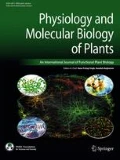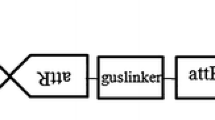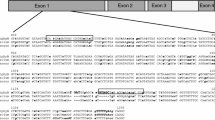Abstract
Agrobacterium mediated genetic transformation of plants have advantages over other methods, especially for making single copy transgenic plants with reduced chances of gene silencing and instability. However, monocotyledonous plant species could not utilize the full potential of this system because of possible limitations in Agrobacterium interaction with monocot plant cells. Agrobacterium attachment as a factor in genetic transformation was studied in the leaf, shoot apex, and leaf derived callus of sorghum (Sorghum bicolor (L) Moench). Pre-induction of Agrobacterium with acetosyringone was found necessary for Agrobacterium attachment to sorghum tissues. All the explants responded positively, with preferential Agrobacterium attachment and colonization around the tissues having actively dividing cells. Callus proved to be the best explant for Agrobacterium attachment as observed in scanning electron microscopy and transient GUS expression. Loss of Agrobacterium attachment was observed with an increase in the degree of tissue differentiation.
Similar content being viewed by others
Abbreviations
- IAA:
-
Indole-3-acetic acid
- IBA:
-
Indole-3-butyric acid
- BAP:
-
Benzyl amino purine
- ADS:
-
Adenine sulphate
References
Aldemita RR and Hodges TK (1996). Agrobacterium tumefaciens-mediated transformation of Japonica and Indica rice varieties. Planta 199: 612–617
Arencibia AD, Carmona ER, Tellez P, Chan MT, Yu SM, Trujillo LE and Oramas P (1998). An efficient protocol for sugarcane (Saccharum spp. L.) transformation mediated by Agrobacterium tumefaciens. Transgenic Res. 7:1–10
Arockiasamy S and Ignacimuthu S (2007). Regeneration of transgenic plants from two indica rice (Oryza sativa L.) cultivars using shoot apex explants. Plant Cell Rep. 26 1745–1753
Bradley LR, Kim JS and Matthysse AG (1997). Attachment of Agrobacterium tumefaciens to carrot cells and Arabidopsis wound sites is correlated with the presence of a cell-associated, acidic polysaccharide. J. Bacteriol. 179: 5372–5379
Cangelosi GA, Hung L, Puvanesarajah V, Stacey G, Ozga DA, Leigh JA and Nester EW (1987). Common loci for Agrobacterium tumefaciens and Rhizobium meliloti exopolysaccharide synthesis and their role in plant interaction. J. Bacteriol. 169: 2086–2091
Douglas CJ, Halperin W and Nester EW (1982). Agrobacterium tumefaciens mutants affected in attachment to plant cell. J. Bacteriol. 152: 1265–1275
Enriquez-Obregon GA, Vazquez-Padron RI, Prieto-Sansonov DL, De la Riva GA and Selman-Housein G (1998). Herbicide resistant sugarcane (Saccharum officinarum L.) plants by Agrobacterium-mediated transformation. Planta206: 20–27
Frame BR, Shou H, Chikwamba RK, Zhang Z, Xiang C, Fonger TM, Pegg SEK, Li B, Nettleton DS, Pei D and Wang K (2002). Agrobacterium tumefaciens-mediated transformation of maize embryo using a standard binary vector system. Plant Physiol., 129: 13–22
Fromm M, Taylor L and Walbot V (1986). Stable transformation of maize after gene transfer by electroporation. Nature 319: 791–793
Fullner KJ, Lara JC and Nester EW (1996). Pilus assembly by Agrobacterium T-DNA transfer genes. Science 273: 1107–1109
Gelvin SB (2000). Agrobacterium and plant genes involved in T-DNA transfer and integration. Ann. Rev. Plant. Physiol. Plant. Mol. Biol 51: 223–256
Gelvin SB (2003). Agrobacterium-mediated plant transformation: the biology behind the “Gene-Jockeying” tool. Microbiol. Mol. Biol. Rev 67:16–37
Graves AE, Goldman SL, Banks SW and Graves ACF (1988). Scanning electron microscope studies of Agrobacterium tumefaciens attachment to Zea mays, Gladiolus sp. and Triticum aestivum. J Bactriol 170:2395–2400
Ishida Y, Saito H, Ohta S, Hiei Y, Komari T, Kumashiro T (1996). High Efficiency transformation of maize (Zea mays L.) mediated by Agrobacterium tumefaciens. Nature Biotechnol 14:745–750
Jefferson RA, Kavanagh TA and Bevan MW (1987). GUS fusions: b-glucuronidase as a sensitive and versatile gene fusion marker in higher plants. EMBO J 6: 3901–3907
Kunik T, Tzfira T, Kapulnik Y, Gafni Y, Dingwall C, Citovsky V (2001). Genetic transformation of HeLa cells by Agrobacterium. Proc. Natl. Acad. Sci. USA 98:1871–1876
Lee MH and Bostock RM (2006). Agrobacterium T-DNAmediated integration and gene replacement in the brown rot pathogen Monilinia fructicola. Curr. Genet 49:309–322
Lima IG, Duarte RT, Furlaneto L, Baroni CH, Fungaro MH and Furlaneto MC (2006). Transformation of the entomopathogenic fungus Paecilomyces fumosoroseus with Agrobacterium tumefaciens. Lett. Appl. Microbiol 42:631–636
Lippincott JA and Lippincott BB (1978). Cell walls of crowngall tumors and embryogenic plant tissues lack Agrobacterium adherence sites. Science 199: 1075–1078
Lorz H, Baker B and Schell J (1985). Gene transfer to cereal cells mediated by protoplast transformation. Mol. Gen. Genet 199:473–497
Matthysse AG, Homes KV and Gurlitz RHG (1981). Elaboration of cellulose fibrils by Agrobacterium tumefaciens during attachment to carrot cells. J. Bacteriol 145: 583–595
Matthysse AG, Yarnall H, Boles SB and McMahan SA (2000). Region of the Agrobacterium tumefaciens chromosome containing genes required for virulence and attachment to host cells. Biochim Biophys Acta 1490:208–212
Matzke MA, Aufsatz W, Kanno T, Mette MF and Matzke AJ (2002). Homology-dependent gene silencing and host defense in plants. Adv Genet 46: 235–275
Mohanty A, Sarma NP and Tyagi AK (1999). Agrobacterium-mediated high frequency transformation of an elite indica rice variety Pusa Basmati1 and transmission of the transgene to R2 progeny. Plant Sci 147: 127–137
Murashige T and Skoog F (1962). A revised medium for rapid growth and bioassays with tobacco tissue culture. Physiol. Plant 15:473–797
Negrotto D, Jolley M, Beer S, Wenck AR and Hansen G (2000). The use of phosphomannose-isomerase as an selectable marker to recover transgenic maize plants (Zea mays L.) via Agrobacterium transformation. Plant Cell Rep 19:798–803
Piers KL, Heath JD, Liang X, Stephens KM and Nester EW (1996). Agrobacterium tumefaciens-mediated transformation of yeast. Proc. Natl. Acad. Sci. USA 93:1613–1618
Potrykus I (1991). Gene transfer to plants: Assessment of published approaches and results. Ann. Rev. Plant Physiol. Plant. Mol. Biol 42:205–225
Sanford J (1988). The biolistic process. Trends Biotechnol 6:299–302
Shillito R, Saul M, Paszkowski J, Muller M and Potrykus I (1985). High-efficiency direct transfer to plants. Biotechnol 3:1099–1103
Smith RH and Hood EE (1995). Agrobacterium tumefaciens: transformation of monocotyledons. Crop Sci 35: 301–309
Stenlid J (2006). Development of a rapid and simple Agrobacterium tumefaciens-mediated transformation system for the fungal pathogen Heterobasidion annosum. FEMS Microbiol. Lett 255:82–88
Tzvi T and Vitaly C (2002). Partners-in-infection: host proteins involved in the transformation of plant cells by Agrobacterium. Trends Cell Biol 12:121–129
Zhao ZY, Cai T, Tagliani L, Miller M, Wang N, Pang H, Rudert M, Schroeder S, Hondred D, Seltzer J and Pierce D (2000). Agrobacterium-mediated sorghum transformation. Plant. Mol. Biol 44: 789–798
Zhu Y, Nam J, Carpita NC, Matthysse AG and Gelvin SB (2003). Agrobacterium-mediated root transformation is inhibited by mutation of an Arabidopsis cellulose synthase-like gene. Plant Physiol 133: 1000–1010
Author information
Authors and Affiliations
Corresponding author
Rights and permissions
About this article
Cite this article
Verma, A., Nain, V., Kumari, C. et al. Tissue specific response of Agrobacterium tumefaciens attachment to Sorghum bicolor (L) Moench. Physiol Mol Biol Plants 14, 307–313 (2008). https://doi.org/10.1007/s12298-008-0028-9
Published:
Issue Date:
DOI: https://doi.org/10.1007/s12298-008-0028-9




